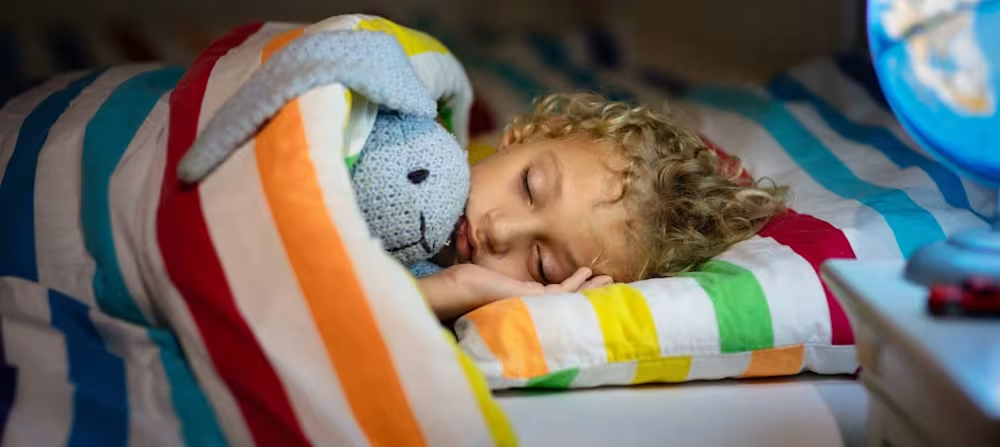How to use sticker charts to improve sleep for preschoolers
Updated Oct 16, 2025

Preschoolers face sleep challenges too! If your child’s sleep is bumpy and you feel like you’ve tried everything, perhaps consider a sticker chart to see if some positive reinforcement (and rewards) can help turn their sleep around.
In this article, we’ll explain what sticker charts are, describe some of the benefits of using sticker charts, and provide some tips and troubleshooting.
Table of Contents
What are sticker charts and how do they work for preschoolers?
A sticker chart is a simple form of positive reinforcement (or motivating tool) to encourage good sleep habits. Each time your child meets a specific goal, like staying in bed all night or waiting for the in the morning, they earn a sticker to add to the chart. For younger children, the sticker itself is often enough of a reward.
If you’d like, you can add milestones — like completing a row or filling the chart — where they earn a larger reward. Many parents prefer non-food rewards, such as extra playtime, a special outing, or choosing a new book or toy. The key is to keep it fun and positive while celebrating their progress!
Sticker charts are most effective for addressing sleep challenges rooted in behavioral habits, such as staying in bed all night, waiting until the clock signals morning, or lying quietly during bedtime routines. These tools work well when the issue involves shaping behaviors that the child can control and improve with encouragement and practice.
However, sticker charts are less effective for sleep disruptions caused by physical needs or external factors, such as hunger, illness, or nightmares. In these cases, addressing the underlying cause — like offering a bedtime snack, treating the illness, or providing comfort after a bad dream — is more appropriate. Behavioral tools like sticker charts can complement these efforts but are unlikely to resolve issues that aren’t within the child’s control.
Sticker charts tend to work best when you clearly specify the behavior you’re looking for so kids know what is expected of them and display the chart so they can see their progress. Often, they work really well for preschool-aged children who are motivated by seeing their progress visually.
The visual nature of sticker charts also supports preschoolers' growing ability to understand routines and rewards. Knowing a reward is coming can help your child complete a task that they may not want to do, such as settling down for bed at the desired time.
Sticker charts also work for preschoolers because they help kids understand the concept of cause and effect. Even at this young age, children can typically comprehend that their actions have consequences — and that they can shape their reality accordingly. When they know they’ll get a special reward for staying in bed all night, for example, they may be more likely to meet that goal. Ideally, just like any skill, the more they practice, the more it will become second nature.
Developmentally appropriate benefits of sticker charts for sleep
Consistency and routine
Having structure and routine at home can even help kids regulate their emotions and be more resilient []. An example of this is having a consistent that can help signal to your child that it’s time to sleep.
Adding a sticker chart to your child’s existing bedtime routine can reinforce desirable bedtime behavior and help your preschooler thrive. For example, you might reward your child with a sticker each night that they successfully follow their bedtime routine or each night they’re in bed on time.
If your kiddo resists bedtime and you find carrying out their typical bedtime routine a challenge, we can help! With the you can turn their bedtime routine into an adventure they’re excited about.
Cognitive development
Many preschoolers are working on understanding sequences and time. They might be learning the days of the week, months of the year, as well as the concepts of past, present, and future. When they look at their chart, they can see the stickers they’ve earned in the past, and they can anticipate the stickers they can earn in the future. You can use this to talk to your child about the passage of days and time, and you can count how many days it might take to earn a reward. Make it fun and educational, too!
Cognitive development and sleep go hand in hand. Studies have found that getting proper sleep can help improve cognition []. By using a sticker chart to reinforce healthy sleep habits in preschoolers, it’s more likely they’ll get the shuteye they need for all of that important growth and brain development.
Emotional growth
As your preschooler earns stickers, fills their chart, and earns rewards, chances are they will gain confidence and pride. Doing so will give them a sense of accomplishment in knowing they worked hard to complete their tasks. A sticker chart is also a regular opportunity for you to give positive reinforcement, which can build up your child’s confidence and self-worth.
Encouraging independence
Preschoolers often still want to “do it myself!” They thrive on independence and accomplishing things on their own. As kiddos get into the sticker chart routine, they can actively track their sleep progress, promoting autonomy.
9 tips for setting up a sticker chart for sleep
Tip #1: Set clear goals
Set your child up for success by setting clear and consistent goals within your existing bedtime routine. You can use easy-to-understand goals like "get into bed by 8:00 PM" or "stay in bed all night."
The clearer you can make the goal, the easier it will be for your child to meet it. For example, the specific goal of “get into bed by 8:00 PM” is more straightforward than the goal of “get into bed on time.” It’s also helpful to keep the goals positive. For example, “stay in bed all night” is preferable over “don’t get out of bed at night.”
Tip #2: Ensure goals are age-appropriate
When creating goals (and rewards) for your child, help set them up for success by making sure the objects are appropriate for their age. For example, a goal for a 2 year old may be staying in bed at bedtime, while a 3 year old goal could be stay in bed until the toddler clock comes on in the morning.
Also consider your child’s sleep schedule when setting goals. Asking a 3 year old who is still napping to go to bed at 7 PM is likely unrealistic since they probably need about 5 - 6 hours of awake time between their nap and bedtime to be sufficiently tired.
Tip #3: Make the chart visually appealing
A sticker chart is a visual reward system and it’s helpful when it appeals to your child. Consider using large, colorful stickers to catch their attention and get them interested in their chart. If your child doesn’t care about the chart or stickers, then it’ll be increasingly harder to motivate them to earn stickers, aka do the things you want them to do. You can even let your preschooler pick out the stickers — they might choose their favorite character or sport.
Tip #4: Use simple rewards often
Especially with younger kids, the excitement of a sticker chart might start to wear off if they’re not regularly getting rewards. Keep in mind the rewards don’t need to be extravagant or expensive (read an extra book before bed when they earn 3 stickers, for example), but it’s helpful to give them frequently.
Tip #5: Work together
Ideally, the sticker chart is a collaboration between you and your child. Some ways you can do that include working together to define the goals, taking turns choosing rewards, giving your kiddo the opportunity to choose or color the sticker chart and letting your child place the stickers on the chart.
Tip #6: Be flexible
Remember that a sticker chart can help improve your preschooler’s sleep by helping to change habits, but it’s not magic. Try to keep it fun and positive and expect the occasional setback and resistance from your preschooler. Aim to be flexible and change the goals, rewards, or structure of the sticker chart along the way.
Tip #7: Display the chart where your kiddo can see it
Display the chart on the bedroom wall, refrigerator, or anywhere your child will see it often. This can serve as a reminder of their positive behavior and encourage them to continue the positive behaviors required to fill up the chart.
Tip #8: Avoid taking stickers away
When using a sticker chart, avoid taking stickers away for missed goals or setbacks. Instead, focus on rewarding positive behaviors and celebrating progress. Removing stickers can feel discouraging and demotivating, especially for young children. If your child struggles, offer encouragement and remind them they can try again next time — sticker charts work best when they remain a positive, motivating experience!
Tip #9: Gradually phase out sticker charts
Once your child’s sleep habits improve, it’s time to transition away from the sticker chart. They’re a great tool to jumpstart a new habit, but they aren’t meant to be used long term. As your child masters their sleep habits, begin phasing out the sticker chart by relying more on verbal praise and encouragement. For example, you might reduce the frequency of stickers — rewarding every few days instead of daily — or celebrate progress with simple acknowledgments like, "You did a great job staying in bed last night!" This helps your child transition to feeling proud of their achievements without external rewards.
What to do when sticker charts aren’t working
Evaluate preschooler’s sleep schedule and sleep environment
A sticker chart might be ineffective if your child is going to bed too late or too early or if their sleep environment isn’t conducive to sleep. A often includes a nap and bedtime around 8:30 - 9:00 PM. A who isn’t napping may have bedtime around 7:00 PM. If your child isn’t tired enough (or is too tired) at bedtime, stickers may help to avoid bedtime battles.
When it comes to , consider turning off technology at least an hour before bed, removing any blue light-emitting devices from your child’s bedroom, and using . Aim to keep the lights dim for 30 - 45 minutes before bedtime to allow sufficient melatonin production [], which signals the internal clock that it’s time for sleep.
Adjust as needed
You might need to adjust the goals, rewards, and/or frequency of rewards if your sticker chart isn’t working. Sometimes, kids lose interest when rewards aren’t coming often enough, so consider using smaller rewards more often. You can also ask your child for input on rewards that excite them.
If your preschooler is struggling to meet your goals, consider simplifying them. For example, if your preschooler is working on transitioning from napping, a daytime sleep goal might be unrealistic. Instead, consider the goal of one hour of quiet time per day in place of their nap.
Focus on small wins
Getting caught up in completely changing your preschooler’s behavior may be frustrating if you don’t see immediate results. Instead, celebrate the small wins, even if it’s earning a star one night for getting to bed on time or only getting out of bed 3 times a night instead of their usual 6. Even small improvements are still improvements! By giving attention to the desired behavior when it happens, the likelihood increases that they will repeat that behavior.
Continue to be positive and patient
Remember that a sticker chart won’t fix sleep challenges in one night. Try to remain positive and patient even when your child has setbacks. Sticker charts are a form of positive reinforcement for sleep, so try to avoid giving negative consequences or pointing out times when your child doesn’t earn a sticker. Instead, make a big deal out of all of the stickers they’ve already earned and remind them that they can meet their goals.
Takeaway
A sticker chart is a positive reinforcement behavior management system that rewards kids for desired behaviors. You can work to improve your child’s sleep by giving them stickers for reaching sleep goals such as staying in bed all night. When they reach predetermined milestones on their chart, they get rewards.
Sticker charts can promote consistency and routine, improve cognitive development, promote emotional growth, and encourage independence.
When you’re using a sticker chart, it’s helpful to set clear goals and reward kids often. Displaying the chart helps remind your child of their progress and can help them take pride in their accomplishments. If you face setbacks when using a sticker chart, try to remain positive and focus on any win, no matter how small. You may need to make adjustments along the way that’s OK!
Sticker charts for sleep FAQ
Share article:
Note: The content on this site is for informational purposes only and should not replace medical advice from your doctor, pediatrician, or medical professional. If you have questions or concerns, you should contact a medical professional.
3 Sources
Table of Contents
Share article:





